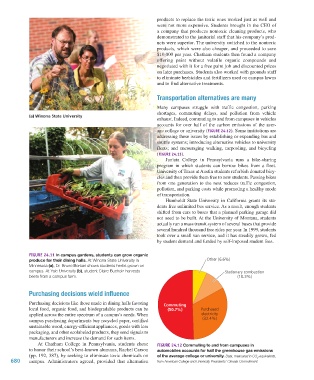Page 681 - Environment: The Science Behind the Stories
P. 681
products to replace the toxic ones worked just as well and
were not more expensive. Students brought in the CEO of
a company that produces nontoxic cleaning products, who
demonstrated to the janitorial staff that his company’s prod-
ucts were superior. The university switched to the nontoxic
products, which were also cheaper, and proceeded to save
$10,000 per year. Chatham students then found a company
offering paint without volatile organic compounds and
negotiated with it for a free paint job and discounted prices
on later purchases. Students also worked with grounds staff
to eliminate herbicides and fertilizers used on campus lawns
and to find alternative treatments.
Transportation alternatives are many
Many campuses struggle with traffic congestion, parking
shortages, commuting delays, and pollution from vehicle
(a) Winona State University
exhaust. Indeed, commuting to and from campuses in vehicles
accounts for over half of the carbon emissions of the aver-
age college or university (Figure 24.12). Some institutions are
addressing these issues by establishing or expanding bus and
shuttle systems; introducing alternative vehicles to university
fleets; and encouraging walking, carpooling, and bicycling
(Figure 24.13).
Juniata College in Pennsylvania runs a bike-sharing
program in which students can borrow bikes from a fleet.
University of Texas at Austin students refurbish donated bicy-
cles and then provide them free to new students. Passing bikes
from one generation to the next reduces traffic congestion,
pollution, and parking costs while promoting a healthy mode
of transportation.
Humboldt State University in California grants its stu-
dents free unlimited bus service. As a result, enough students
shifted from cars to buses that a planned parking garage did
not need to be built. At the University of Montana, students
actually run a mass transit system of several buses that provide
several hundred thousand free rides per year. In 1999, students
took over a small van service, and it has steadily grown, fed
by student demand and funded by self-imposed student fees.
(b) Yale University
Figure 24.11 In campus gardens, students can grow organic
produce for their dining halls. At Winona State University in Other (6.6%)
Minnesota (a), Dr. Bruno Borsari shows students herbs grown on
campus. At Yale University (b), student Claire Bucholz harvests Stationary combustion
beets from a campus farm. (10.3%)
Purchasing decisions wield influence
Purchasing decisions like those made in dining halls favoring Commuting
local food, organic food, and biodegradable products can be (50.7%) Purchased
applied across the entire spectrum of a campus’s needs. When electricity
campus purchasing departments buy recycled paper, certified (32.4%)
sustainable wood, energy-efficient appliances, goods with less
packaging, and other ecolabeled products, they send signals to
manufacturers and increase the demand for such items.
At Chatham College in Pennsylvania, students chose Figure 24.12 Commuting to and from campuses in
to honor their school’s best-known alumnus, Rachel Carson automobiles accounts for half the greenhouse gas emissions
(pp. 192, 387), by seeking to eliminate toxic chemicals on of the average college or university. Data, measured in CO -equivalents,
680 campus. Administrators agreed, provided that alternative from American College and University Presidents’ Climate Commitment. 2
M24_WITH7428_05_SE_C24.indd 680 13/12/14 10:40 AM

